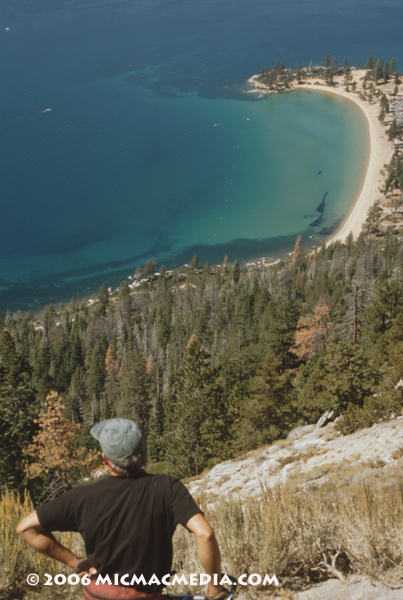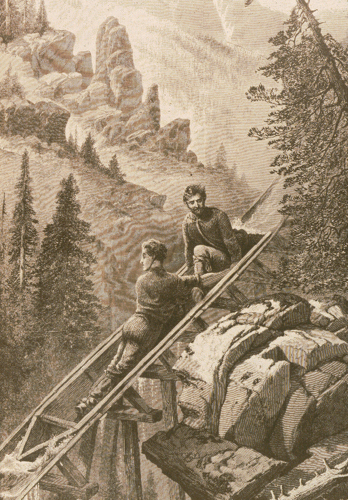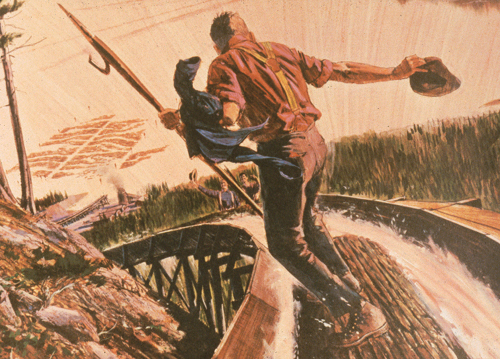|
Tahoe Nugget #63:
Dare to Ride the Flume! (3 Photos)
April 11, 2006
Every summer, mountain bikers flock to Lake Tahoe's East Shore, eager to ride the old Flume Trail. Littered with wooden planks from a 19th century water flume, this narrow pathway hugs the steep west slope of the Carson range. It challenges the courage and endurance of adventuresome cyclists. Although a ride along the Flume Trail can stir the heart, the real excitement associated with flumes ended more than a century ago.
James W. Haines built the first "V flume" in Nevada in 1869. Shaped like the letter "V" this innovative flume was rigged to move timber efficiently down from the upper slopes of the Carson Range to the valley floor where it could be hauled to the bustling Comstock mines. The long, winding flumes were built tight enough to hold water and strong enough to carry heavy logs up to forty feet long. High elaborate trestles supported the flume down inaccessible canyons and across steep-sided chasms, moving the timber quickly and cheaply down the mountainside.
In 1875, an East Coast newspaperman was treated to the trip of a lifetime. H.J. Ramsdell, a New
York Tribune reporter, was assigned to Virginia City to report on the Comstock activities. He got more of a story than he bargained for.
While Ramsdell toured the various operations, mining magnate John Mackay suggested a visit to the Bonanza V flume. Two days later, Ramsdell met with wealthy moguls James Fair and James Flood in Virginia City. Joining them on the trip was John Hereford, the contractor who had built the big flume. The four men left in two buggies, crossed Washoe Valley, and headed for the timber country north of Tahoe. Once there, Ramsdell climbed to the top of the trestle work to see the huge logs roar down the flume. "It was like the rushing herd of buffalo," he wrote. "I preferred to view the flume, in active working, from a distance."
After Ramsdell returned to the main group, Flood and Fair challenged the journalist to join them in a trip down the flume by hog trough. Hog troughs were crude boats, V-shaped like the flume and sixteen feet long. The 200-pound reporter could not believe what he was hearing, but he thought, "…if men worth 25 to 30 million dollars apiece could afford to risk their lives, I could afford to risk mine."
The first boat was lowered and suddenly they were off. When the terrified reporter opened his eyes, they were already streaking down the mountainside. The trestle was 70 feet high in some places, and since Ramsdell was lying down, he could see only the aerial flume stretching for miles ahead. Meanwhile the second boat was making better time. This second craft crashed into the first and Flood was thrown into the rushing water. The rest of the men hung on for dear life. The tangled confusion of splintered wood and terrified men slid fifteen miles in just 35 minutes, scaring the daylight out them but saving themselves a whole day of traveling by horse-drawn carriage.
Reporter Ramsdell was able to write a good story, but his main satisfaction came from the fact that his wealthy hosts were so battered and sore, they could not get out of bed the next day.
Photo #1: Cyclist (Larry from Philly) gazes down to Sand Harbor from Tahoe Flume Trail.
Photo #2: Harper's Weekly sketch of riding a flume
Photo #3: At the end of the work week, loggers were always in a hurry to hit the saloons and brothels of Virginia City.



|





